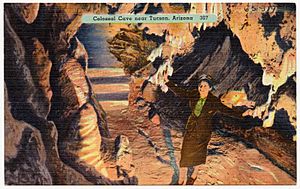Colossal Cave (Arizona) facts for kids
Colossal Cave is a huge cave system located in southeastern Arizona, United States. It's near the town of Vail, about 22 miles (35 km) southeast of Tucson. This amazing cave has about 3.5 miles (5.6 km) of passages that have been explored and mapped. Inside, the temperature stays around 70°F (21°C) all year long. In the past, it was known by other names like 'Mountain Springs Cave' and 'Five–Mile Cave'.
Colossal Cave is an ancient karst cave. This means it was formed by water dissolving rock over a very long time. Guides often call it a "dry" cave. This means the beautiful rock formations inside, like stalactites and stalagmites, are no longer growing. The water that once helped them grow has moved to other places. One nearby cave, Arkenstone Cave, is still "active" and its formations continue to grow. Long ago, from about 900 to 1450 AD, Native American groups like the Hohokam, Sobaipuri, and Apache Indians used Colossal Cave.
Contents
Discovering Colossal Cave's Secrets
The area around Colossal Cave has a rich history. In 1876, a man named Sidney H. Ramsey owned the Mountain Springs Station. This was a stop for stagecoaches traveling between Tucson and Tres Alamos. The station was known for its fresh water, good grass for animals, and tasty meals.
A few years later, around 1879, Solomon Lick and his partner took over the ranch. They advertised it as a great place for families and hunters. In January 1879, Solomon Lick and some friends found a large opening in the ground. They explored about 500 feet (152 meters) into what they thought was an old mine or cave.
Early Explorations and Amazing Finds
Soon after its discovery, a team explored the cave further using candles to light their way. They found that the air inside was bad because of large amounts of bat droppings. They also found signs of old fires and many animal bones, including over 500 deer antlers. This suggested the cave was once a resting place for the Apache people. The explorers were amazed by the beautiful rock formations, like stalactites, which they brought out to show others.
In 1884, local newspapers reported that most of "The Mountain Springs Cave" was still unexplored. The farthest anyone had gone was about half a mile (0.8 km).
A Hideout for Train Robbers?
Legend says that this underground cave was used as a hideout by train robbers. These robbers held up the Southern Pacific Express train twice. The first time, they stole $3,000 in money. The second time, they took gold and silver Mexican coins.
More Explorations and Guano Mining
By 1890, William Shaw was in charge of the Mountain Springs Ranch. That year, he explored the cave for five hours with soldiers from Fort Lowell. They used candles and magnesium wire to light up the dark chambers. They were amazed by the many finger-shaped and kidney-shaped stalactites and stalagmites. They also found very deep holes where they could barely hear a rock hit the bottom.
In the early 1900s, a company started digging for bat guano (bat droppings) in the cave. This guano was used as fertilizer. They dug a 75-foot (23-meter) tunnel to reach it. It's believed they shipped seven train carloads of guano to Los Angeles before it ran out.
How Colossal Cave Got Its Name
In December 1917, Jim Westfall and Alfred A. Trippel claimed the cave and the land around it. They wanted to turn it into a tourist attraction. Trippel asked Lynn Hodgson, who was good at exploring caves, to survey it. After his survey, Hodgson told Trippel that "the cave was colossal." Hodgson later said this is where the name "Colossal Cave" came from.
Another idea for the name comes from Byron Cummings of the University of Arizona. He explored the cave around the same time and might have given it its famous name.
Colossal Cave Mountain Park Today
Today, Colossal Cave is a very popular place for tourists. It's part of the Colossal Cave Mountain Park. The park also protects two other caves, Arkenstone and La Tetera, which researchers are studying. Pima County Natural Resources, Parks and Recreation owns and manages the park.
The park offers many fun things to do:
- La Posta Quemada Ranch Museum: This museum teaches visitors about the history of people and nature in the park and the surrounding area. It especially focuses on the park's caves.
- Civilian Conservation Corps Museum: This museum shows the history of the Civilian Conservation Corps (CCC) and their work in the park during the 1930s.
- "The Cowboy" Sculpture: This is a bronze statue of a cowboy created by Buck McCain. It reminds visitors of the park's past as a working ranch.
- Horseback Trail Rides: You can explore the park's trails on horseback.
- Picnic and Camping Facilities: There are places to have picnics and camp overnight.
- Butterfly Garden: A beautiful garden where you can see many different kinds of butterflies.
See also



